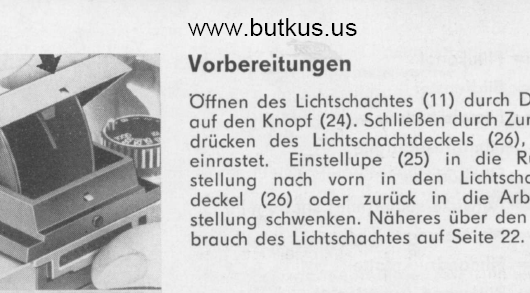Exakta RTL1000
Camera Manual
posted 12-8-'02
This camera manual library is for reference
and historical
purposes, all rights reserved.
This page is copyright© by
 , M. Butkus,
N.J.
, M. Butkus,
N.J.
This page may not be sold or distributed without the
expressed
permission of the producer.
I have no connection with any camera company.
If you find this manual useful,
how about a donation of
$3 to:
M. Butkus, 29 Lake Ave.,
High Bridge, NJ 08829-1701
and send your e-mail
address
so I can thank you.
Most other places would charge
you $7.50 for
a electronic copy
or $18.00 for a hard to read Xerox copy.
This will help me to continue to host this site,
buy new manuals, and pay their shipping costs.
It'll make you feel better, won't it ?
If you use Pay Pal, use the link below.
Use the above address for a check, M.O. or cash.
To main Camera
Manual site
CLICK HERE TO CONTINUE TO PDF
MANUAL MADE FROM HTML PAGE
CLICK HERE TO GO TO
Exakta Pocket Guide PDF
MADE FROM MANUAL
Click here for English version w/meter info
Exakta RTL 1000 TTL - Penta Prism
Exakta RTL1000 Bedienungsanleitung
EXAKTA RTL TTL Penta Prism
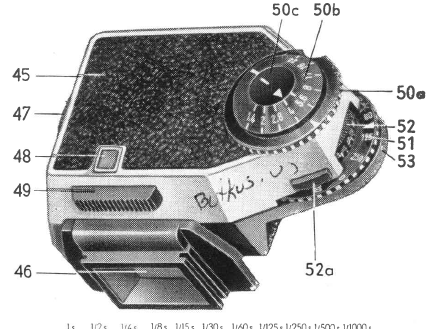
EXAKTA
RTL1000
The EXAKTA RTL 1000, maintaining the use of the world-renowned quick-change
bayonet and offering plenty of valuable innovations to up-to-date miniature
photography, continues the great traditions of this high-performance camera.
These innovations are based on the well-approved principle of the true
single-lens reflex camera with its always parallax-free correspondence of reflex
image and photograph. These are the most important features of your EXAKTA RTL
1000:
Simple arrangement of all operating controls. Interchangeable viewfinder
systems: Finder Hood, Penta Prism, one TTL Penta Prism for the automatic
exposure timing with internal measurement, the lens being stopped down or fully
opened. Focal-plane shutter made of metal laminate and destined for the complete
series of shutter speeds from 8 seconds to 1/1000 second, 1 second to
1/1000 second with built-in delayed-action release. B setting for any long
shutter speeds. Right-hand and left-hand release. Quick tensioning with a 30°
preliminary elevation for series of photographs. Instant return mirror.
Synchronizing switch for electronic flash units and flashbulbs: electronic flash
units being synchronized with approximately 1/125 second,
fast-burning flashbulbs with 1/30 second. Automatic film
loading system with free selection of film. Frame counter automatically
returning to its initial position. Rewind release catching in interchangeable
lenses with original EXAKTA quick change bayonet and automatic diaphragm
mechanism with internal release. On the left-hand release there can be employed
any earlier EXAKTA lenses with automatic diaphragm mechanism. Accessories for
any field of application.
|
We are delighted that you have chosen an EXAKTA
RTL 1000 and we wish you every success with your new camera. We would like
to advise you, however, to read this instruction manual carefully before you
start using your camera. In this way you will obtain the greatest possible
service from it, since you will eliminate from the outset the possibility of
operating it incorrectly, and possibly damaging the mechanism. The EXAKTA
RTL 1000 is a high-quality precision instrument which can naturally only be
expected to answer all your requirements when it is always hand led
correctly.
|
Contents
Page
Operating controls of the
EXAKTA RTL 1000
4
Preparations for use
6
Film loading
7
Operating the shutter
11
Operating the lens
15
Using the Finder Hood
22
Using the Penta Prism
24
Using the TTL Penta Prism
26
Interchanging the viewfinder
systems
27
Exchanging the focusing screen
27
Changing the film
28
Flash photography
30
Care of the camera and its
accessories
32
Accessories
cover
|
|

|
|
Operating controls of the EXAKTA RTL 1000
1 = Tensioning lever of mechanism for low shutter speeds
2 = Shutter-speed setting knob for 2 seconds to 8 seconds
(mechanism for low shutter speeds)
3 = Release knob of preset timing
mechanism (relayed-action release)
4 = Release lock on the right-hand
release
5 = Right-hand release |
6 = Eyelets for carrying strap or cord
7 = Frame counter
8 = Film-type reminder disc
9 = Rapid-wind lever
10 = Shutter-speed setting knob for second to 1 second and B setting
11 = Finder hood
12 = Red aligning dot on the camera
(for lens changing)
|
|
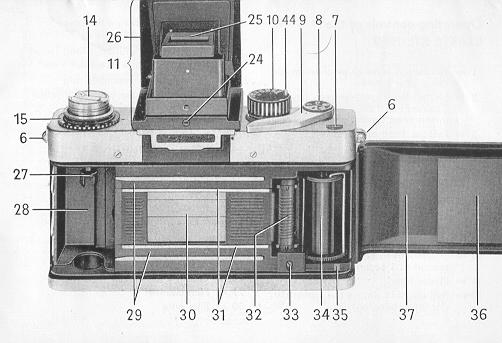 |
13 = Red aligning dot on the lens
(for lens changing)
14 = Rewind crank with knob and fixture
for attaching the accessory
shoe
15 = Film-sensitivity reminder ring
16 = Left-hand release (with connection
for cable release)
17 = Aperture-setting ring
18 = Depth-of-field scale
19 = Lens locking lever
20 = Flash nipple |
21 = Distance-setting ring
22 = Lens
23 = Knob for stopping down the lens
24 = Knob for opening the finder hood
25 = (Swing-up) focusing magnifier
26 = Cover of finder hood
27 = Rewind arbor (with carrier)
28 = Cassette chamber
29 = Film channel
30 = Film gate
|
| 31 = Film-guide runners
32 = Film-wind sprocket
33 = Film rest
34 = Take-up spool (with catch bows)
35 = Mark
36 = Film-pressure plate
37 Camera back (hinged)
38 = Rewind declutching button
39 = Tripod thread
40 = Diaphragm switch (for disengaging
the automatic diaphragm mechanism)
41 = Penta Prism
42 = Eyepiece of Penta Prism
43 = Unlocking knobs for the viewfinder
system
44 = Driver pin for the coupling of the
TTL Penta Prism (page 26)
|
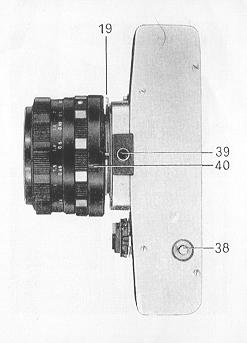 |
 |
Preparations for use
The Finder Hood (11) is opened by pressing on the knob (24). To close the
hood, press the cover of the Finder Hood (26) backwards until it locks in
position. The focusing magnifier (25) can be swung either forward into the
position of rest in the cover of the Finder Hood (26) or backwards into the
working position. For further information on the use of the Finder Hood see page
22.
Swing the release lock (4) to the stop on the right (marking dots ore
staggered): the shutter can be released by pressing on the right-hand release
(5). When you have finished taking pictures, swing the release lock (4) to the
stop on the left (the marking dots are opposite each other) : now it will be
impossible to release the shutter, which means protection against unintentional
exposures. (No locking in case of the left-hand release (16))
|
| Film loading
Loading and changing the film must not take place in direct sunlight!
-- The EXAKTA RTL 1000 uses standard 35 mm miniature film, in
standardized, commercial cassettes of 12, 20 or 36 exposures, to make negatives
24 mm x 36 mm the beginning of the film having a shape according to the
illustration. Perfect film transport requires faultless film cassettes. Daylight
loading spools should only be inserted in capsules made by the same
manufacturers.
1. Pull out the knob of the rewind crank (14) as far as
the second stop: now the camera back (37) will open.
|
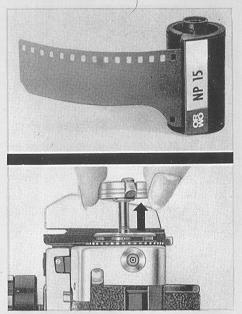 |
 |
2. Place the cassette containing the
unexposed film in the cassette chamber (28). Push the knob of the
rewind crank (14) backwards, twisting it gently: the carrier of
the rewind arbor (27) must engage with the cassette core.
3. Pull the beginning of the film (29) as far as the green
mark (35), and push it with its (lower) perforation from above
under the film rest (33) and, accordingly, over the film-wind
sprocket (32). The catch bow of the take-up spool (34) must not
stand upwards! |
| 4. Closing camera back (37) by
pressing it lightly home, the locking taking place automatically.
5. Now swing the rapid-wind lever (9) right up to its stop and let it
return. Release the shutter by means of the right-hand release (5) or by means
of the left-hand release (16). Repeat these operations until the figure "1" in
the automatic frame counter (7) will be below the mark.
|
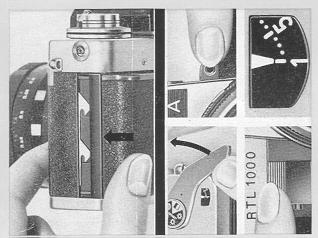 |
|
= black-and-white film
= reversible color film for daylight
= reversible color film for artificial light
= negative color film for daylight
= negative color film for artificial light
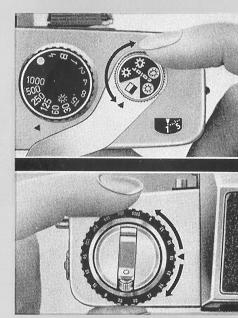 |
6. A special setting
of the frame counter is not necessary since the latter,
springing automatically back as soon as the camera back is
opened, will begin to operate when the camera back is closed.
-- Afterwards the frame counter
will indicate the number of photographs already taken on the
film placed in the camera.
7. When film is loaded, set the film-type reminder disc (8) and the
film-sensitivity reminder ring (15) as reminders of the type and sensitivity of
the film that is in the camera. Turn the disc and the ring in either direction
until the appropriate references will be opposite the orange-colored triangles.
On the film-sensitivity reminder disc (15) the figures from 9 to 33 are DIN
values, whereas the figures from 6 to 1600 denote ASA values. The film-type
symbols on the reminder disc (8) have the following meaning:
The EXAKTA RTL 1000 is now ready for action! |
| Operating the shutter
1. The shutter is tensioned and the film wound on by operating the
rapid-wind lever (9). This lever should always be swung right up to its stop,
and will then spring back of its own accord. -- The tensioning
of the shutter and the transportation of the film are coupled (avoiding
unintentional double exposures and blank frames). It is impossible to release
the shutter before it has been fully tensioned and the film wound on. It is also
impossible to release the shutter in intermediate positions of the rapid-wind
lever (9).
In order to enable users to work in quick succession e.. g. in case
of series of photographs) the rapid wind lever (9) can be employed with
preliminary elevation: intermediate position at approximately 30" after the
position of rest.
|
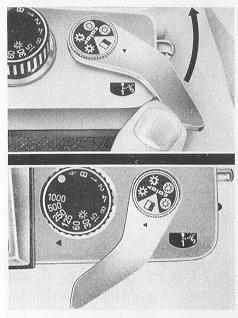 |
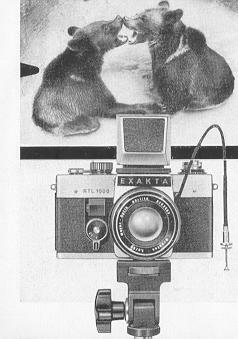 |
2. The image in any of the viewfinder
systems (Finder Hood, Penta Prism, and TTL Penta Prism) will
be visible even after the shutter has been released (instant
return mirror). The red warning signal in the image in the
viewfinder system indicates that the camera is not yet ready
for action, and that the rapid-wind lever (9) must be wound
before the shutter is ready for release (See illustration:
image seen through the Penta Prism).
3. Setting the shutter speeds.
You will safely succeed in taking photographs with shutter speeds from 1/1000
second to 1/30 second (white figures on the shutter-speed setting knob (10) "by
hand", i.e. without the use of a
tripod. For any exposure times from 1/15 second to 1 second (orange-colored
figures on the shutter-speed setting knob (10) and for still longer exposure
times with the B setting, the camera should be screwed on to a tripod and a
cable release be employed. |
Tripod thread (39) at the bottom of the EXAKTA RTL 1000, thread for the
cable release in the left-hand release (16). All setting operations can be
effected before and after tensioning the shutter.
| Selection of exposure times from
'/1000, sec. to 1 second and B setting
Turn the shutter-speed setting knob (10) until the
desired figure or the B will be at the orange-colored
triangle. The figures from 2 to 1000 represent fractions
of seconds (e. g. 1/125 sec.). Intermediate speeds
cannot be set. In case of the B setting the shutter will
remain opened as long as the pressure on the right-hand
release (5), on the left-hand release (16) or on a cable
release screwed into the left-hand release (16)
(important for exposure times longer than 8 seconds)
continues. Accordingly, the B setting will permit any
exposure times you like (e. g. for taking night and
indoor exposures).
|
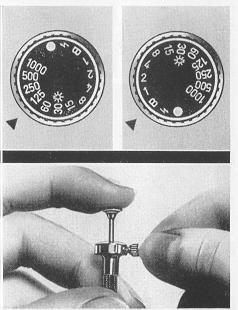 |
For working with the B setting a cable release with time-exposure lock can be
recommended: After depressing the cable release, operate the time exposure lock.
The shutter will remain opened without having to keep ones finger constantly on
the release (also eliminating camera shake) until the time-exposure lock is
disengaged.
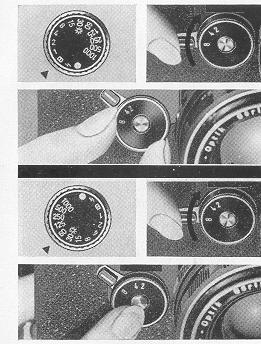 |
Selection of exposure times from 2
seconds to 8 seconds
Turn the shutter-speed setting knob (10) until the B is in line with the
orange-colored triangle. Swing the tensioning lever of the mechanism for low
shutter speeds (1) in the clockwise direction to the stop. (This operation may
be performed before or after tensioning the shutter). Turn the shutter-speed
setting knob (2) of the mechanism for low shutter speeds until the desired
exposure time (2 sec., 4 sec.. or 8 sec.) will be opposite the mark on the
tensioning lever of the mechanism for low shutter speeds (1). Release the
shutter by means of the right-hand release (5) or of the left-hand release (16).
Selection of exposure times from 1/1000 sec. to 1 sec. with delayed-action
release
Turn the shutter-speed setting knob (10) until the desired exposure time will
be opposite the orange-colored triangle Swing the tensioning lever of the
mechanism for low shutter speeds (1) in the clockwise direction to the stop
( tension the preset timing mechanism; this operation may be performed
before or after tensioning the shutter).
Release the shutter only with the release knob of the preset timing mechanism
(3). Exposure will take place after 8 seconds. |
| Operating the lens
1. The lenses of the EXAKTA RTL 1000 are equipped with internal
release of the fully-automatic pressure diaphragm. Select the desired aperture
number by turning the aperture-setting ring (17): the desired aperture number
must be opposite the orange-colored triangle.
The smaller aperture numbers, e. g. f 1.8. 2, 2.8, 4 indicate relatively
large diaphragm openings: these permit brief exposures, but give only
shallow depth of field. The larger aperture numbers, e. g. 16, 22, indicate
relatively small diaphragm openings requiring longer exposure times, but giving
great depth of field, Further information on the depth of field will be found on
page 19. 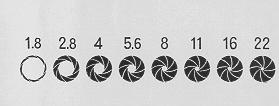 |
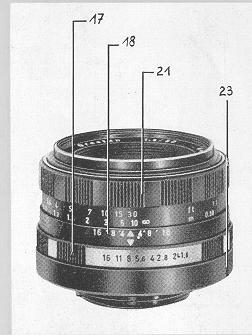 |
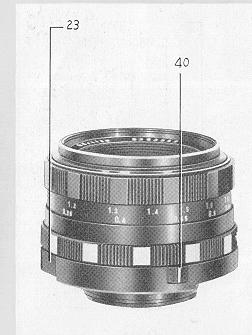 |
2. For critical focusing
according to the image in the viewfinder system the
lenses with internal release of the fully-automatic
pressure diaphragm are fully opened. Owing to an
energy store incorporated in the camera the
automatic pressure diaphragm becomes the higher
value "automatic spring diaphragm". The lens is
stopped down automatically as soon as the shutter is
released. In case of all the longer exposure times
and of exposures taken by means of the
delayed-action release the lens is also fully opened
only after exposure. For focusing trials and in
order to check the depth of field stop the lens down
by way of trial by means of the stop-down knob (23).
The automatic diaphragm mechanism is disengaged by
means of the diaphragm switch (40) (white mark =
engaged, orange-colored mark = disengaged). Then the
lens is stopped down manually by operating the
aperture-setting ring (17). This is important for
the use of the TTL Penta Prism and for close-ups by
means of extension-increasing accessories. |
| The lens is focused by turning the
distance-setting ring (21) and by checking the
definition of the image in the viewfinder system.
After focusing, the correct camera-subject distance
will be in line with the
orange-colored triangle. The lower values on the
distance scale indicate meters, whilst the larger
values possibly arranged above them represent feet.
All distance are measured from the back of the
camera to the subject.
Focusing for infra-red photography: When using
infra-red film, first focus the image in the
view-finder system normally, then note the distance
indicated by the orange-colored triangle (either in
feet or in meters or the infinity symbol), and turn
the focusing ring to set this distance against the
orange-colored dot, the so-called infra-red setting
mark which is to the right of the normal setting
mark. By doing this, the image produced by the
infra-red rays will be brought into sharp focus in
the film plane of the camera and consequently will
appear sharp in the negative. |
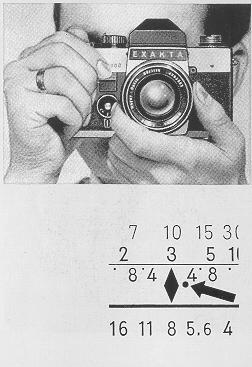 |
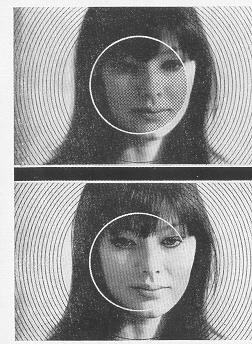 |
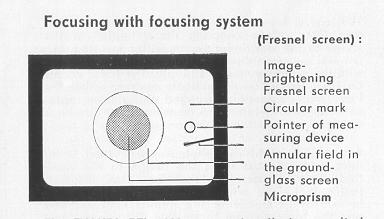
|
|
Focusing with focusing system (Fresnel screen):
Image-brightening Fresnel screen Circular mark
Pointer of measuring device Annular field in the
ground-glass screen Microprism
The EXAKTA RTL 1000 may optionally be supplied
with a focusing system in all its viewfinder units.
With this focusing system, a sharp image is mainly
obtained using the annular field in the ground-glass
screen (for moving subjects, photographs taken with
a magnifier, and photomicrographs). To increase the
accuracy of focusing or In case of slowly moving and
stationary subjects focusing is performed by means
of a microprism field. In case of incorrect focusing
the microprism field will show an image which in
blurred to a greater degree (the blurred image
"flickers"). The lens will be correctly focused when
the image in the microprism Is at its sharpest (i.e.
no flicker effect). It is however, absolutely
necessary to focus with a large diaphragm opening
(small aperture number) (this is important above all
in case of lenses without internal release).
|
|
With apertures of 5.6 and smaller, the image in the
microprism field will appear relatively sharp, even
with the lens incorrectly focused. This, of course,
will lead to unsatisfactory results. For extreme
close-ups of magnifications greater than 1: 1 and
for photomicrogrophy, the microprism cannot be used.
The rest of the image in the viewfinder (Fresnel
field) does not serve for focusing the lens.
Reading off the depth of field: When the depth of
field is great, objects at widely varying distances
from the camera will form a sharp image. After
focusing the precise extent of this sharp zone will
be indicated by the depth-of-field scale (18) on the
lens: on either side of the orange-colored setting
mark (triangle) you can read off from the distance
scale where the depth-of-field zone begins and ends
for any specific aperture setting. If the relevant
aperture number on one side of the central
distance-setting mark is in line with the infinity
symbol (oo)
or -- beginning from the center
-- even beyond it, then the depth of field
will extend right up to infinity.
On the right above one example:
Distance setting 3 meters, aperture f 8 depth of field extends from something
more than 2 meters to 5 meters.
|
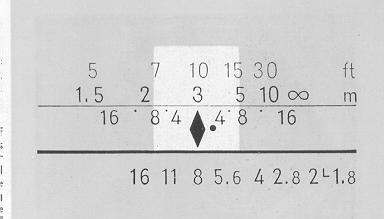
|
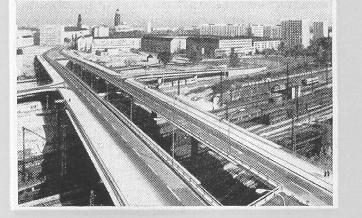 |
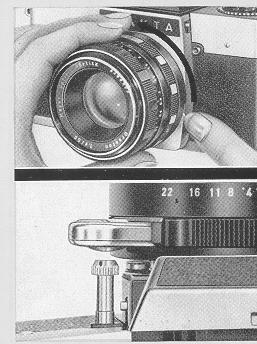 |
Changing the lens (22) : Press the
locking lever (19) towards the lens. Then turn the
lens to the left until the orange-colored dots (12
and 13) ore in line. Lift the lens out towards the
front, --
To insert a lens, proceed in the reverse sequence: line up the
orange-colored dots, and turn the lens to the
right until it locks in place.
In the EXAKTA RTL 1000 there can be used special purpose lenses with focal
lengths ranging from the shortest to the longest. All lenses for the earlier
EXAKTA and EXA models can be used. However, in order to be able to operate their
automatic diaphragm mechanism (external release), you have to screw an adapter
into the left-hand release (16).
|
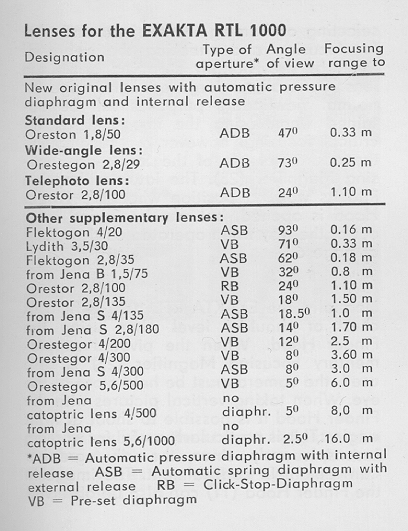 |
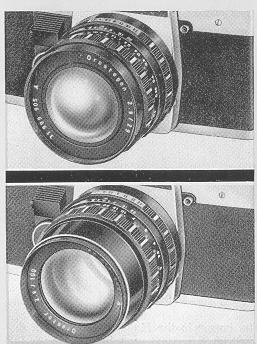 |
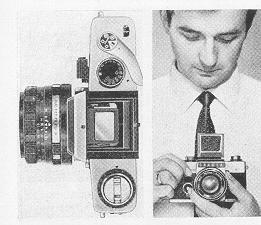 |
Using the Finder Hood
The image in the Finder Hood (11) of the EXAKTA RTL 1000 may be
used both for selecting or framing the subject, and also for focusing and
checking the depth of field, by provisionally stopping down the lens. Generally,
a large enough image for normal view finding purposes will be obtained when
using the image field; for critical focusing, however, we recommend the
additional use of the Swing-up Focusing Magnifier (25), The latter will spring
into its working position when the Finder Hood is opened, but can be folded back
out of the way when operated as described at page 6,
Normally, the EXAKTA RTL 1000 is held at chest or
shoulder level when using the Finder Hood. When the pivoted supplementary
Focusing Magnifier (25) is also used, the camera must be held close to the eye.
When taking vertical pictures with the Finder Hood it is possible to shoot at
right angles. This is particularly useful for working inconspicuously since the
photographer can remain in concealment. |
|
|
|
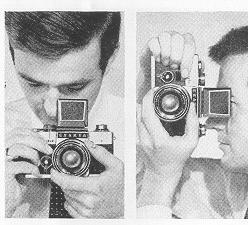
|
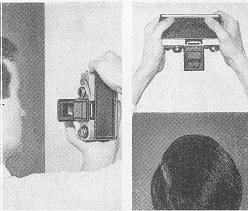
|
| The image in the Finder Hood (11) can
also be observed from below when the camera is held above the head. This
will prove very useful when taking pictures over walls or over the heads of
crowds. |
Users who normally wear spectacles
should use their distance glasses for focusing with the Finder Hood. For
interchanging the Finder Hood, see page 27. |
Using the Penta Prism
The Penta Prism (41) serves the same purpose as the Finder Hood,
with the exception, that the image in the viewfinder will invariably be
upright and laterally-correct no matter whether the camera is held
horizontally or vertically; this is particularly useful when taking pictures
of moving subjects, since the image in the viewfinder will move in the same
direction as the subject itself. With very rapidly-moving subjects the
camera can thus be ,,panned" by swinging it gently in the direction of
motion of the subject, as for example, with racing cars.
When employing the Penta Prism (41) the camera
should always be held at eye level. Viewing the image through the eyepiece
(42) may be effected with either eye. This is the most advantageous way to
use the EXAKTA RTL 1000 with Penta Prism: The camera should be focused with
the thumb and index finger of the left hand, the right index finger being
used for releasing the shutter.
|
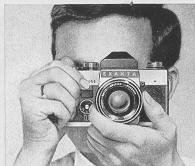
|
|
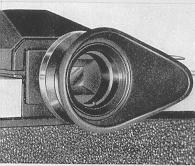 |
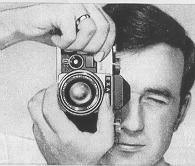 |
Photographers who normally wear spectacles should use their distance
glasses for focusing with the Penta Prism. For fitting and removing the
Penta Prism see page 27.
An invaluable accessory for use with the Penta Prism is the flexible
eyepiece cup:
this is fitted on to the eyepiece (42) of the Penta Prism and shields it
from distracting stray light. It is also helpful for spectacle wearers
since vision-correction senses made by ones optician can be inserted into
the revolving mount, making it possible to focus without wearing glasses. |
|
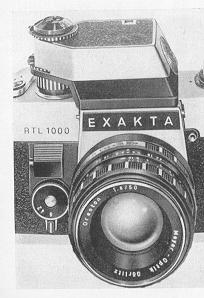 |
TTL Penta Prism
(Automatic exposure timing with internal measurement)
The TTL Penta Prism provides the EXAKTA RTL 1000 with an automatic exposure
timing on the basis of internal measurement through the lens (Through The Lens =
TTL). This automatic system, taking into account film sensitivity, exposure
time, and aperture number, will always measure only the light being effective
for the photograph to be taken, This method of measurement is of greatest
importance above all when employing special-purpose lenses (angle of view equal
to the angle of measurement) as well as when working with extension-increasing
accessories and filters (the exposure factors are automatically included in the
measurements).
The use as a viewfinder unit is identical to that of the Penta
Prism: always upright and laterally-correct image in the viewfinder.
Photographers who normally wear spectacles should use their distance
glasses. For fitting and removing the TTL Penta Prism as well as for
exchanging its image field screens, see next page. -- For the use of
the automatic exposure timing (internal measurement) a detailed
instruction leaflet is joined to the Penta Prism.
|
| Interchanging the viewfinder systems
Each of the viewfinder systems of the EXAKTA RTL 1000 (Finder Hood, Penta
Prism, and III Penta Prism) can be exchanged. -- When any of
the viewfinder units is being removed from the camera, the two unlocking knobs
(43) must be pressed downwards with thumb and index finger of the left hand, and
the viewfinder unit withdrawn upwards with the right hand without tilting. On
replacing a viewfinder unit, it must be inserted squarely and vertically and be
pressed downwards until it clicks into position. Never use force!
Exchanging the focusing screens
The focusing screen of the viewfinder units of the EXAKTA RTL 1000 can be
exchanged so that, if desired, one of the special focusing screens can be used.
-- Remove the viewfinder unit from the camera. The focusing screen
should be gripped by the long sides, and withdrawn frame the viewfinder unit. To
refit the focusing screen it should again be held by the long sides (do not
touch the mat surface) and pressed Into the frame of the viewfinder unit.
|
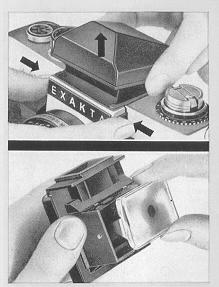 |
|
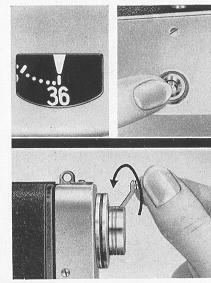 |
Changing the film
When the frame counter (7) indicates the maximum of exposures to be taken
with the film with which the camera is loaded (12, 20 or 36), the film should
now be rewound into its cassette.
1. Press the rewind declutching button (38) into the camera.
2. Swing the rewind crank (14) out, and turn it with the right hand
evenly and slowly in the direction of the arrow (clockwise direction) until it
is felt that it turns more easily, which means that the film has now been
rewound. (If the film is rewound at too great a speed, static electricity will
cause discharge marks to appear on the negatives.)
|
| 3. Swing the rewind crank (14) inwards and
withdraw the knob of the rewind crank to the stop.
4. Open the camera back (37). Remove the cassette
containing the rewound film from the camera. Depress the knob of the rewind
crank (14) back. On the next tensioning of the shutter the rewind declutching
button (38) will automatically return into its normal position.
|
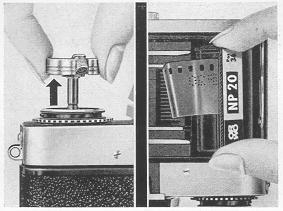 |
|
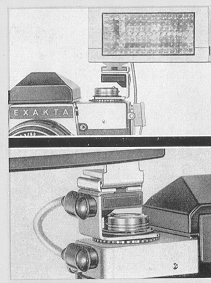 |
Flash Photography
The EXAKTA RTL 1000 is equipped with an X synchronization for electronic
flash units and flashbulbs. The synchronizing cable of standard or electronic
flashguns should be connected to the flash nipple (20). By means of an accessory
shoe which has to be attached below the knob of the rewind crank (14), flashguns
can be fastened directly to the camera.
The accessory shoe is also adapted for flashguns with central contact except
that in this case the flash nipples of the camera and of the accessory shoe must
be connected by means of the special cable delivered with the flashgun.
|
In case of electronic flashguns turn the
shutter-speed setting knob (10) until the flash symbol will be
in line with the orange-colored triangle. The shutter speed
set in this way is approximately 1/125 sec. Lower shutter
speeds (1/60 sec., 1/30 sec., 1/15 sec. etc.) can also be set,
for example 1/15 sec. or 1/8 sec. in case of electronic
flashguns without storage condensers, designed for mains
operation only.
In case of fast-burning miniature flashbulbs (for example NARVA Xl,
Osram AG 3 B. XM 1 B, XM 5 B as well as AG 3 B Super, PF 1 B,
PF 5 B) turn the shutter-speed setting knob (10) until the
flashbulb symbol and, accordingly, the fig. 30 will be in line
with the orange-colored triangle. This means that the shutter
speed 1/30 sec. has been set.
In case of longer-burning flashbulbs set 1/15 sec. or any
lower shutter speed.
For all flashlight sources used with the EXAKTA RTL 1000 the effective
exposure time will be approximately equal to the duration of the flash, and not
to the time that the shutter remains open (this is important when taking
photographs of moving objects).
|
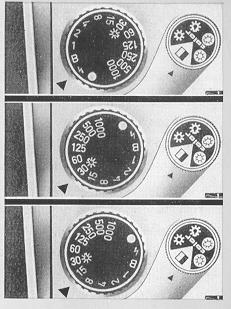 |
Care of the camera and lenses
Always keep the camera in its ever-ready case with the lens (or
lens cap) and viewfinder unit in position; alternatively it may be kept wrapped
in a fluff-free cloth. All parts which are easily accessible from the outside
should be kept clean and dusted with a soft brush. This applies particularly to
the film channel (29) with the film-guide runners (31) and the film-wind
sprocket (32), the cassette chamber (28), the film rest (33), the take-up spool
(34) and also the camera back (37) including the pressure plate (36). The reflex
mirror should only be dusted when absolutely necessary, using a clean soft brush
without applying any pressure. Protect the camera against moisture, dust,
wind-borne sand, etc. Never touch the glass surfaces of the lenses, the focusing
screens or the eyepieces of the two Penta Prisms or the mirror with the fingers.
These glass surfaces should be cleaned when necessary only with a soft,
fluff-free linen cloth. It is highly inadvisable to attempt to interfere with
the mechanism of the camera; repairs should be undertaken only by authorized
servicing agencies.
| Accessories
Finder Hood
Penta Prism
TTL Penta Prism for internal measurement
Eyepiece cup for Penta Prisms
Ever-Ready Case
Counter-light Lens Hood with screw-in mount M 49 x 0.75
Accessory shoe
Angular viewfinder for Penta Prisms
Focusing telescope for Penta Prisms Bayonet rings and tubes as well as
Two-in-one ring for close-ups
Adapter rings with tappet 12.5 mm and 25 mm for lenses with internal release
(for close-ups)
Miniature Bellows Attachment Auto couple Extension Release for lenses with
external release
Special ring with socket for cable release
Special adopter ring with double cable release
Multi-Purpose equipment for close-ups, reproductions and photomicrography,
etc., consisting of the following parts:
Large Bellows Attachment
Transparency Copying Attachment
Copying Stand for direct fastening of the camera
|
Repro Unit (with Large Bellows Attachment, with
Lighting equipment, if required) and others
lighting equipment for Copying stand and Repro Unit
Special-purpose lens 1 2.8/50 from Jena, in sunk
mount far Large Bellows Attachments
Lens Reversal Rings
Adapter Rings for using photomicrography lenses
Special Focusing Screens
Lens Magnifier insert with Top Lens
Macro-Micro Photometer
Ring flash Units RB 1 and RB 2
Kolpofot
Endoscope Attachment
Spectroscope Adapter Ring and Sleeve
Adapter far Astrophotography
Microscope Attachment
Universal tripod
Focusing slide
|
|
Should you want further information, we shall be
pleased to send you any special leaflets. The
illustrations in this manual may differ in certain
details from the actual appearance of the camera and its
accessories.
|

